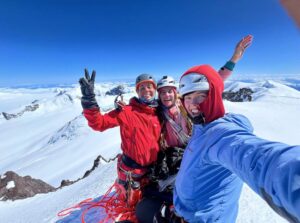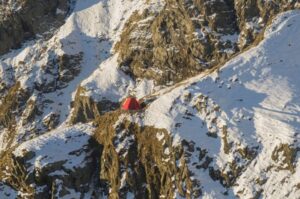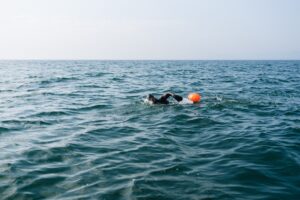Humankind’s greatest achievements have been where barriers were broken and sacrifices made to push us forward to a brighter future. But some great achievements lie in our ability to defy all odds in mortal peril. Some Houdini-esque escapes are almost miraculous. Here, we celebrate five of the most captivating survival stories ever told — one each from the desert, mountains, ocean, jungle and polar regions.
Ricky Megee

An emaciated Ricky Megee. Photo: quora.com
In 2006, Queensland local Ricky Megee found himself stranded in the Australian Outback after being drugged, left for dead and at the mercy of nature for the next 71 days in the Tanami Desert.
The Outback’s extreme heat and scarcity of food and water were his main concerns. His primal instincts made him eat whatever moved: frogs, insects, lizards. He also sought waterholes and drank his own urine. For shelter, he built a humpy — a temporary shelter — from an overturned feed trough, branches and stones. Gradually he became more emaciated; infections spread over his body.
During his 10 weeks in this Australian purgatory, the fight for his body’s survival was only matched by the fight for his mind. He battled hopelessness, loneliness and his inner demons. Sometimes he felt that he was going insane. Dark thoughts came and went, never acted on but still an option. To suppress his boredom, he “watched the Simpsons in his head.” But with sanity hanging by a thread, he was solely sustained by the thought of rescue.
Before his ordeal, Megee had had a rough life, and the range of skills he picked up from such odd jobs as a fisherman, club bouncer and electrician proved useful. He had a solid build, no medical issues and a knack for improvising. Most important, perhaps, he was stranded near the end of the wet season, which gave him access to more water than at other times of year. When he was eventually rescued, he had lost 60 kilos — half his body weight.
Steve Callahan

Steve Callahan’s memoir. Photo: Goodreads.com
People say that water is the stuff of life. But survivor Steve Callahan would disagree. His extraordinary tale of survival started in 1982 with a trans-Atlantic sailing race from England to the Caribbean island of Antigua. En route to Antigua, his heart lurched at the terrifying sound of wood hitting a hard object. Soon after, his boat began to sink. He inflated his 1.8m life raft and dove in the flooded hold to collect bags of food, containers, his sleeping bag, a few tools and his spear gun before they sank forever. In his later memoir, Callahan described himself as “an aquatic caveman”, fighting off the dangers of open water, dehydration, starvation and insanity. For Callahan, the water that surrounded him was the stuff of nightmares.
Yet he turned out to be the perfect candidate for an extended stay in the Atlantic. He was a skilled navigator, naval architect and sailor. With his years of experience living and racing on the water, he was already a master at improvisation and keeping calm under duress. He fished for mahi-mahi with his spear gun. He caught rainwater and built his own evaporation chamber from mundane items like a Tupperware box, empty tins and black cloth. This surprisingly successful rig supplied him with drinking water every day. Although he had the basics covered, he wondered whether he would ever be rescued. His optimism and humor kept him going. After 76 days, he was picked up by fishermen on the southeast coast of Guadeloupe.
Uruguayan Air Force Flight 571

Surviving members of the rugby team.
It is one of the most grueling, disturbing and gripping stories of our time; the story of a team en route to a nightmare. The “Old Christians” rugby team chartered a Uruguayan Air Force Fairchild FH-227D to travel from Montevideo to Santiago for a match. The manifest consisted of 40 passengers, including the crew, friends, and family of the team. Because of bad weather, the flight diverted to Mendoza, Argentina, where the inexperienced pilot chose to fly directly to Santiago via the Andes. The pilot’s error proved fatal. A miscalculation, thick clouds and turbulence caused the plane to crash in an area known as the Valley of Tears. And tears indeed fell. For the next 72 days, these university students were forced to be a team as never before, and made heartbreaking choices to survive.
Their success at creating snowshoes and warm clothing from suitcases, seat belts and some wool blankets could not stop the hard questions forming in their minds. They were trapped in the snowy, sterile Andes, far from help. The only food source was the frozen bodies of dead friends. All the survivors were Roman Catholic, and some of them refused to commit what they believed was a grave sin. A few chose to starve instead. Apart from the question of religion, it was also a question of morals.
One of the group leaders, Roberto Canessa, a medical student who was soon to take a vow to do no harm, felt the weight of this decision the most. He described eating his friends as rape and a vile “invasion of privacy”. However, it was he who made the first cut, performing the act with as much dignity and ceremony as he could muster. They all agreed to allow their body to be eaten if they perished.
The other leader, Nando Parrado, did not carry the same guilt. Rather, he saw through a clear lens of raw necessity and logic, which invariably convinced the survivors to do what they had to. The combination of their two leadership styles got them through this ordeal. Eventually, Parrado, Canessa and a third man made a desperate trek over the glaciated mountains and eventually encountered people below. Helicopters then managed to evacuate the other 14 survivors.
Juliane Koepcke

Juliane Koepcke after rescue.
In life-or-death situations, kids are the most vulnerable: They have never experienced the brute force of life and the lessons needed to get through it all. In this case, 17-year-old Juliane Koepcke learned all-too-soon the heartbreak of losing a parent and the need to push grief aside to stay alive.
On Christmas Eve 1971, Koepcke, the daughter of two renowned biologists in the Amazon, was en route with her mother to her high school graduation on LANSA Flight 508 when lightning struck their plane, which crashed in the rainforest. Strapped to her seat, she fell over three kilometres through the air when the plane broke apart. Miraculously, she survived the fall with only a broken collarbone, an open wound on her right arm and a swollen right eye. She was the sole survivor.
Having lived in Peru her whole life, under the tutelage of her parents, Koepcke earned the nickname of “jungle child” as a young girl. She was sharp for her age, observant and very knowledgeable of the inner workings of a tropical rainforest. Her precocious knowledge saved her life. She wandered the forest to find a river, then followed it downstream to find civilization, a valuable lesson that her father taught her. After 10 days of navigating thick jungle and nursing an arm wound infected with maggots, she found a boat. She recalled a memory of her father cleaning a maggot-infested wound from their dog with gasoline and did the same to her arm. The next morning, she was rescued by fishermen.
Tyson’s Wonderful Drift

An account of Tyson’s drift. Photo: amazon.com
In 1872, George Tyson was the navigator on Charles Francis Hall’s expedition to northwest Greenland aboard the Polaris. Hall had died the year before under mysterious circumstances — that’s another story — and the ship was stuck in the ice during a violent autumn storm. It looked as if the Polaris was in imminent danger of being crushed, so some of the crew, including Tyson, started to offload the supplies. At that moment, the ship broke free and drifted away. Nineteen men, plus some Inuit who were helping the expedition, were stranded on an ice floe, which soon floated into open Baffin Bay. It was late October.
Throughout the winter, they moved slowly south on their ever-diminishing ice cube. The Inuit kept everyone alive by hunting seals for food, clothing and shelter. Using blubber lamps, or kudloos, they were even able to melt water. Tyson tried to impose strict rationing of their food supplies from the Polaris, such as bread, pemmican, ham, meats and soups, but a contentious clique of German sailors — Tyson described them as “tremendous eaters and outrageous grumblers” — resisted the discipline. Nevertheless, incredibly, after six months they were spotted by a whaling ship off the coast of Newfoundland and rescued. They had drifted 2,400km south. Thanks to the Inuit, everyone survived.






